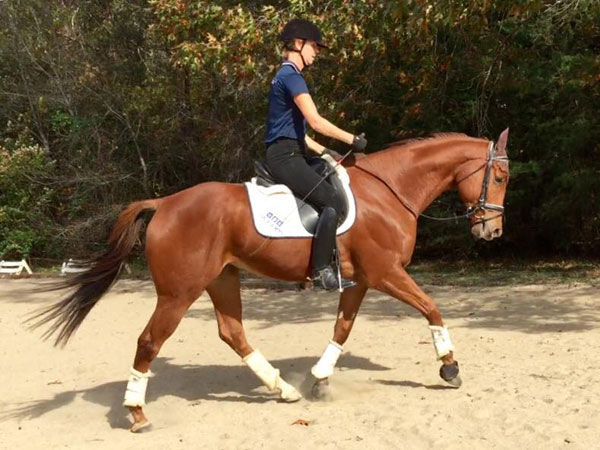Once, when I had been frustrated during a ride because I had hoped to work on flying changes but ended up releasing that ambition as it became apparent my horse was so tense during the warm up, all I could do was keep working on the warm up. A fellow dressage chum wisely said to me, “Some days are canter days and some days are trot days.”
How very true! And I find with Forrest that, given his age (4), and his background (OTTB), this is a reliable formula to follow so that I don’t throw too much at him during one session. If he’s super loose in the warm up, sure, I’ll add a canter here and there, but mostly, we focus on one particular gait per ride, after lots of suppling work at the walk.
I don’t feel he’s ready for me to throw a truckload of transitions at him at this point, so what we are currently focusing on is adjustability within the gaits. Upon watching a canter video I sent her, Jane Savoie gave us some wonderfully positive feedback but also pointed out to make sure that when Forrest comes up into the bridle, his withers must follow suit. In short, you don’t want a raised neck and a dropped back! So…this day is a trot day and our next blog will feature a canter day with all the following applied.
Keeping Jane’s advice in mind, after our warm up, I begin to test the waters by asking myself, “Can I, in the next stride, ride his neck down, keeping the swing and the rhythm?” If I’ve been successful in riding my horse into an honest connection, the answer should be, “Yes!”

Following this “over-the-back” stretch, I then up the ante and ask myself, “Now, in the next stride, can I shorten my reins, close my legs, and bring both his back and withers up and develop some thrust from behind?” And if I’ve ridden Forrest correctly, the answer should be, “Yes!”
Because I don’t have mirrors to check our image, just video (thanks to my weary but obliging husband), I have to really rely on feel and experience to confirm my horse is now quite balanced and carrying himself. And, naturally, my feel isn’t always correct! So the sure-fire way to test this is to release my inside rein (particularly the right as this tends to be the shoulder Forrest would, left to his own devices, happily lean on for the rest of his natural life) completely and see if my horse will remain honestly connected into the outside rein and Forrest said, “Yes!”

I’m extremely proud of his effort and certainly don’t expect him to maintain this for more than a few strides at a time, so I take back the contact and we continue on with our session with lots of verbal praise.

And just for fun, to break up the work, I turn him towards a line of trot poles at the far end of the arena and…holy moly!! Maybe I should think about renting this horse out as a ‘bounce house’ for kids’ parties!













